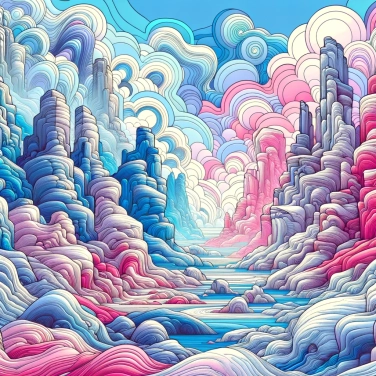Rock formations can resemble animals due to natural processes of erosion, fracturing, and weathering that shape the rock in a way that creates forms reminiscent of living creatures.

Rocks that resemble animals are not intentionally shaped by nature. It all starts with classic geological processes, such as sedimentation, the cooling of volcanic lava, or underground pressure on rock layers. Over time, movements of tectonic plates create folds, faults, or cracks in the rock, giving it rough and irregular shapes. These unlikely forms constitute the raw material that natural elements like rain, wind, or temperature will then slowly sculpt. These combined processes create silhouettes that, by chance, surprisingly resemble dog heads, bird shapes, or even imaginary creatures.
Erosion is when water, wind, frost, or even plants gradually attack the rock. Over time (and we often talk about thousands or millions of years), these forces sculpt the stone like an invisible artist. Sometimes, they erode more fragile or softer areas, leaving the more resistant parts intact. The result: rocks that strangely resemble animals. A crack becomes a mouth, a protrusion turns into a snout, some isolated blocks take on the appearance of ears or legs. The longer the rock undergoes this process, the more marked and recognizable its final shape will be. It's like a natural sculpture made solely through the patience of nature, without any hammer or chisel.
Pareidolia is the phenomenon that drives your brain to see familiar shapes, often animals or humans, in mundane objects like rocks. This mechanism stems from the brain's natural tendency to quickly recognize known patterns in order to make rapid decisions for survival. Essentially, your brain prefers to find an approximate but quick answer rather than taking its time and risking missing out on crucial information. It works particularly well with animals because our brain has always been programmed to quickly detect living beings around us to spot prey or avoid potential predators. So, even if it's just a rock with vaguely suggestive contours, your brain jumps straight to the conclusion: "Hey, that looks like a lion!" or "Look, a lying elephant!"
In New Zealand, the Elephant Rock in Whakatāne surprisingly resembles a pachyderm drinking with its trunk dipping into the water. In Brittany, at Ploumanac'h, the Rabbit sculpted by erosion catches the eye, ears perked up towards the sky. In the United States, in Arizona, the famous Camel Rock clearly evokes a camel sitting quietly in the desert. In Ha Long Bay, Vietnam, Ga Choi island shows two rocks seemingly challenging each other, resembling two roosters in the midst of a fight. Just as impressive in Iceland, Hvítserkur is a massive basalt rock that resembles a huge rhinoceros leaning over the sea. These world-famous examples perfectly illustrate how nature sometimes offers us striking animal sculptures without human intervention.
Since ancient times, humans have noticed these animal shapes in the rocks and often attributed symbolic or spiritual meanings to them. Some rock formations are seen as ancient sacred guardians, while others are viewed as petrified memories of mythological events. Among Indigenous peoples, these rocks sometimes took on a living or protective character, representing creatures from their legends. Even today, these cultural accents influence what we see: the same rock may be a simple block for some or a mythical animal rich in history for others. It is our collective memory, filled with ancient stories, folk tales, and founding myths, that shapes our perceptions and spontaneously drives us to seek familiar figures in the landscape.
The psychological phenomenon that allows us to identify faces or animals in inanimate objects has a specific name: pareidolia. This phenomenon is also responsible for beliefs in fantastic or divine apparitions in nature.
In Bryce Canyon, United States, the Paiute Native Americans explain the presence of the strange hoodoo rock formations as former living beings petrified by the trickery of the Coyote god, illustrating how much the rock formations have influenced local myths.
In Japan, there is a practice called 'Suiseki,' a traditional art that involves collecting, displaying, and admiring stones that evoke landscapes or animals, serving as a cultural testament to the universal fascination with unusual natural forms.
Some famous animal-shaped rock formations have served as natural landmarks for travelers to navigate for centuries, such as the famous elephant-shaped rock formation located in the Westman Islands of Iceland.
Yes, many astonishing rock formations have inspired myths and legends. For example, the Lion Rock of Sigiriya in Sri Lanka and the formations of Monument Valley in the United States have greatly influenced local beliefs and narratives.
Indeed, pareidolia explains our brain's tendency to identify familiar shapes, particularly animal or human forms, in random elements such as rocks or clouds. This pertains to a cognitive mechanism for the rapid recognition of familiar visual patterns.
Absolutely, this phenomenon can be observed on all continents and at various latitudes. Each region has unique rock formations, shaped by erosion or local geology, that spark our imagination.
Yes, many of these famous rock formations are accessible to tourists. For example, Elephant Rock in Iceland, Bear Rock in France, or Camel Rock in the United States are visited each year by thousands of curious individuals or environmental enthusiasts.
The majority of them indeed are. The combined effect of wind, water, and temperature variations naturally shapes the rock formations. However, some formations can also result from geological events such as tectonic movements that influence the initial shape before erosion occurs.

No one has answered this quiz yet, be the first!' :-)
Question 1/5